关于东亚海域
- 格式:docx
- 大小:21.21 KB
- 文档页数:4
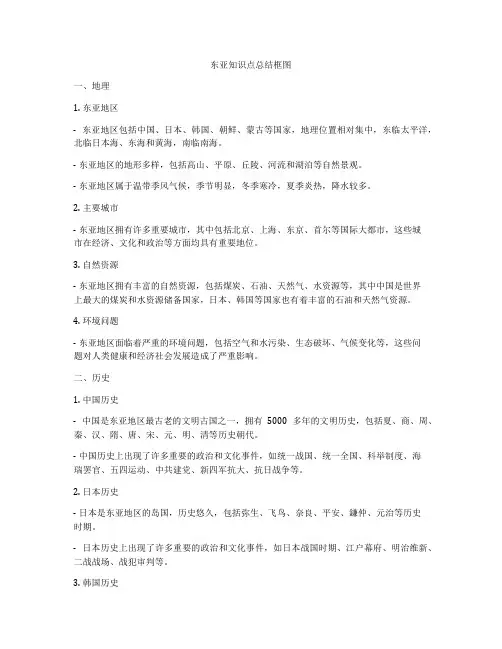
东亚知识点总结框图一、地理1. 东亚地区- 东亚地区包括中国、日本、韩国、朝鲜、蒙古等国家,地理位置相对集中,东临太平洋,北临日本海、东海和黄海,南临南海。
- 东亚地区的地形多样,包括高山、平原、丘陵、河流和湖泊等自然景观。
- 东亚地区属于温带季风气候,季节明显,冬季寒冷,夏季炎热,降水较多。
2. 主要城市- 东亚地区拥有许多重要城市,其中包括北京、上海、东京、首尔等国际大都市,这些城市在经济、文化和政治等方面均具有重要地位。
3. 自然资源- 东亚地区拥有丰富的自然资源,包括煤炭、石油、天然气、水资源等,其中中国是世界上最大的煤炭和水资源储备国家,日本、韩国等国家也有着丰富的石油和天然气资源。
4. 环境问题- 东亚地区面临着严重的环境问题,包括空气和水污染、生态破坏、气候变化等,这些问题对人类健康和经济社会发展造成了严重影响。
二、历史1. 中国历史- 中国是东亚地区最古老的文明古国之一,拥有5000多年的文明历史,包括夏、商、周、秦、汉、隋、唐、宋、元、明、清等历史朝代。
- 中国历史上出现了许多重要的政治和文化事件,如统一战国、统一全国、科举制度、海瑞罢官、五四运动、中共建党、新四军抗大、抗日战争等。
2. 日本历史- 日本是东亚地区的岛国,历史悠久,包括弥生、飞鸟、奈良、平安、鎌仲、元治等历史时期。
- 日本历史上出现了许多重要的政治和文化事件,如日本战国时期、江户幕府、明治维新、二战战场、战犯审判等。
3. 韩国历史- 韩国位于朝鲜半岛,历史悠久,包括古朝鲜、高句丽、新罗、统一新罗等历史时期。
- 韩国历史上出现了许多重要的政治和文化事件,如朝鲜王朝、三国统一、韩战、光州事件、南北统一等。
4. 朝鲜历史- 朝鲜也位于朝鲜半岛,历史悠久,包括古朝鲜、高句丽、新罗、统一新罗等历史时期。
- 朝鲜历史上出现了许多重要的政治和文化事件,如朝鲜王朝、三国统一、抵抗侵略、金日成走向执政等。
三、文化1. 中国文化- 中国文化是东亚地区最重要的文化之一,包括语言、文字、思想、宗教、文学、美术、音乐、舞蹈、戏剧等方面。
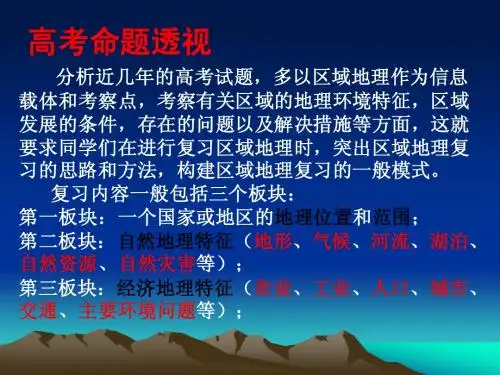

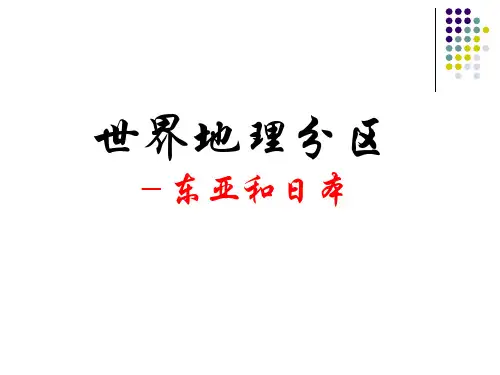
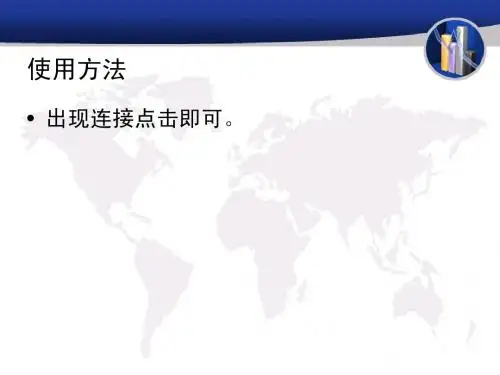
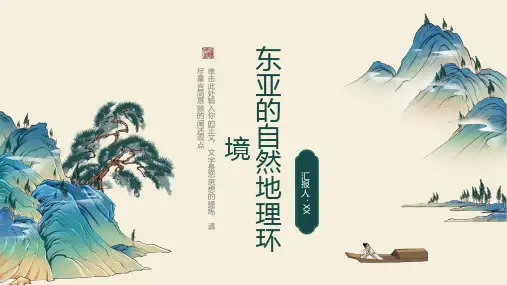
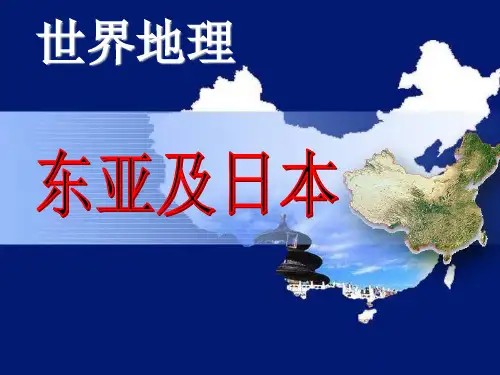

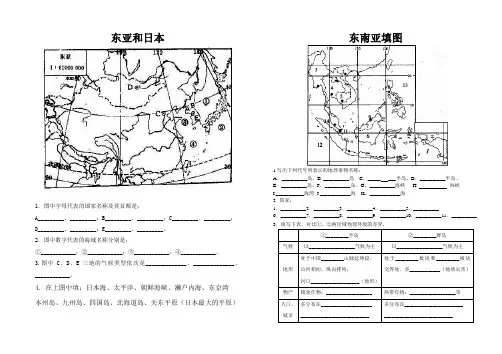
东亚和日本1.图中字母代表的国家名称及其首都是:A_________、_________;B_________、_________;C_________、_________;D_________、_________;E_________、_________。
2.图中数字代表的海域名称分别是:①____________;②____________;③____________;④____________。
3.图中C、D、E三地的气候类型依次是______________、______________、____________,4. 在上图中填:日本海、太平洋、朝鲜海峡、濑户内海、东京湾本州岛、九州岛、四国岛、北海道岛、关东平原(日本最大的平原)东南亚填图1.写出下列代号所表示的地理事物名称:A.__________岛、B. __________岛C._____ ___半岛、D.__________半岛、E.__________岛、F.__________岛、G、__________海峡H.. 海峡I.___________海湾J.____________海K、____________海2. 国家:1.__________2.__________3.__________4.__________5.__________6.__________7.__________8.__________9.__________10.__________11.__________ 3.填写下表,对比①、②两区域地理环境的差异.南亚填图1. 海域:P_____湾;Q_____海、E所在岛屿_______、A所在半岛__________.2. 国家:A__________;B__________;C__________;D__________;E__________;F__________;G__________;H__________。


《东南亚南亚研究》2018年第2期17世纪东亚海域贸易的新态势陈衍德摘要:17世纪的东亚海域贸易出现了一些新的发展态势,具体表现为贸易主体的多元化,贸易方式的多样化,域内域外贸易 的一体化,贸易屏障的空疏化等。
将东亚海域视为一个整体,并将其纳入世界体系当中进行探讨,同时尝试将以国家为行为体的 研究,与以集团、个体为单元的研究结合起来,可以发现我们以前在研究过程中所忽视的很多“客观存在”。
在分析贸易行为的同 时,我们还可以对政治、文化等相关领域的关联性产生更多的关注。
尤其是海外华商与区域贸易的关联,可以让我们排除非历史 主义因素的干扰,从而还历史以本来面目。
关键词! 17世纪;东亚海域;贸易主体;一体化;空疏化中图分类号:K31.3 文献标识码:A 文章编号= 1674—6392(2018)02—0010—10收稿日期:2018 -04 -27作者简介:陈衍德(1950 ~),男,厦门大学人文学院历史系教授。
主要研究领域:东南亚史、华侨华人史。
相比以往,17世纪东亚海域(包括东北亚与东南 亚沿岸及岛屿,以及南海、东海等)的贸易出现了新的 发展态势。
这一态势表现为:第一,贸易主体的多元化。
在朝贡贸易与私人贸 易并存的情况下,后者所占份额越来越大,在总体贸 易上的地位越来越重要。
私人贸易的非官方性,使其 贸易主体的多元化成为必然。
中国沿海以海盗、走私 商人,或二者兼而有之的身份从事的非法贸易,历时 久远,其主体本身就是多元化的,后来则大多为郑氏 集团招降纳叛。
在日本南部,幕府控制薄弱的西南诸 藩经营着超越规定的大量海外贸易。
在台湾海峡两 岸,郑氏海上武装商人集团一度控制了东亚海域的关 键水道,并以其强大的军事力量为后盾,压制了西方 在东亚海域的商业势力,并建立了自己的政权。
形式 上独立但处于中、日两强夹缝中的琉球,则利用其“万 国津梁”的海上地理优势,成为东亚海域各国各地区 的贸易中转港。
东南亚各小国和城邦,则以其土特产 吸引着东西方商人前往从事贸易,形成了万商汇集的 众多据点。
高中地理东亚知识点篇一:亚洲和东亚区域地理知识总结精华一、亚洲(一)亚洲的自然环境1、位置:亚洲大部分位于东半球、北半球(1)绝对位置:大致在10°S~80°N、30°E~180°之间,跨寒、温、热三带。
(2)海陆位置:东临太平洋,南临印度洋,北临北冰洋。
2、世界第一大洲(2)世界上跨纬度最广的洲(3)东西距离最长的洲3、地形地势(1)特点:地形复杂,中部山地、高原面积广大,约占全洲面积的3/4 ,平原分布在大陆周围地区。
地势中间高、四周低。
(2)重要地形区世界最高的高原:青藏高原亚洲大陆沿30°N的地形剖面亚洲最大的平原:西西伯利亚平原4、河流(1)特点:多发源于中部山地、高原,呈放射状流入海洋,内流区面积广大。
(2)主要河流: 鄂毕河、叶尼塞河、勒拿河、黄河、长江、湄公河、恒河、印度河沿80°E地形剖面图5、气候(1)特点:类型复杂多样、季风气候显著、大陆性气候分布广。
(2)气候类型:热带雨林气候、热带季风气候、亚热带季风气候、(共9种)温带季风气候、地中海气候、热带沙漠气候、温带大陆性气候、高原山地气候、寒带气候。
亚洲气候复杂多样的原因① 纬度位置:跨寒、温、热三带,故亚洲既有温带气候,也有热带、寒带气候。
② 海陆位置:靠近海洋能接受海洋湿润气流的影响,形成湿润气候;内陆因距海较远,难以受到海洋上湿润气流的影响,从而形成干旱气候。
③ 地形因素:亚洲地形复杂,地势起伏很大,同一纬度地带海拔不同,气温、降水均有差异。
海拔3500米以上的地区,有高山气候,受地形因素的影响,气候呈现垂直地带性。
注意:受纬度位置影响,日本北部、朝鲜、韩国北部及我国的秦岭—淮河以北地区为温带季风气候,日本南部、韩国南部及我国的秦岭—淮河以南地区为亚热带季风气候。
受海陆位置的影响,日本为典型的海洋性季风气候,降水丰沛,气温年较差较小;朝鲜半岛的季风气候具有过渡性的特点;我国除沿海外,为大陆性季风气候,与世界同纬度地区相比,气温年较差偏大,降水的季节变化和年际变化也较大。
东亚海域史的一些思考(仅供课堂讨论)我们都知道,东亚海域史的概念是一种来自日本学界的表述。
它和日本学界长期以来的学术关注和兴趣有着直接的关系。
而与此同时,这个概念对于中国的历史学者来说同样有着一定的启发意义,这也是为什么当我们知道这个概念之后,会感觉很有共鸣,甚至借用了这样一个概念,来开设一门研究生的课程的原因。
正如我们在上课时曾经讨论到的,基本上我认为,东亚海域史的概念,对中国历史研究者的启发意义无外乎两点:一是研究视野的扩展,二是新材料的关注和应用,即材料边界的扩宽。
首先,关于研究视野的扩展。
我们知道,比起陆地来说,中国历来不那么重视海洋,至少不像日本那样重视,而这也是为什么今天中国在海洋的问题上总是处处受限的原因。
东亚海域的概念,从某种程度上提示我们,中国也是一个海洋国家,事实上还是一个海洋大国。
回到历史的层面上,我们同样可以发现,如果把目光聚焦到海洋的因素上,会发现很多以往被忽略但却很有价值的问题,这就是研究视野扩展的结果。
从实际研究的层面来说,传统的历史研究注重国别史或者国与国的关系史,比如中韩关系、中日关系、韩日关系,且一般都集中在个体或者两者关系的讨论,很少有关注三者以上关系的研究者,大家可以想一下,我们是不是很少听到有谁说我是研究中日韩三国关系的?我想这就是一个问题。
同时,我们也知道,现在很流行一种所谓全球史的观念,在我看来,这种观念有其特定的意义,但其局限性在于没有十分切实的操作性,这也是为什么到目前为止,全球史更多地还是停留在理论探讨的层面,或者是表现为在所谓全球史的大背景下表述的国别史和国际关系史,中国学界的情况尤其如此。
相对于过于笼统的全球史,更为人所接受的大概是稍微向下聚焦一点的所谓区域史,比如亚洲史,东亚史。
相对于中国学者来说,区域史的提出就研究的操作性来说,无疑更强一些。
那么,从东亚史到东亚海域史,这两者的区别又在哪里呢?我们知道,提出东亚海域史,我们不是要研究海洋本身,那是地理学家或者海洋生物学家的任务。
作为历史学者,我们研究的对象还是人和事,我们只是将海洋作为一种联系的方式,就像传统的将陆地作为联系方式的研究一样。
在东亚世界几千年的历史中,海洋是一个客观的存在,发生在这片海域上的事件,或者因为这片海域的存在而发生的事件也客观存在,如果忽略了这一部分的内容,我们所了解的东亚历史无疑就是不完整的。
反过来说,只有将东亚海域纳入研究的视野,我们才能够了解一个真正完整的东亚。
这就是我认为东亚海域史的提出最关键的价值所在,也是它比之于所谓的东亚史更近一步的地方。
其次,关于材料边界的拓展的问题。
我们知道,历史研究说白了是一种依靠材料说话的研究模式,视野的变化和关注点的转移,带来的一个直接的结果就是,我们以往不那么关注或者被我们忽略的新材料可能进入我们的视野。
从宏观的层面来说,比如,研究中国问题的学者,会发现用韩国和日本的材料同样对研究中国有很大的帮助;又比如,研究中韩关系史,不能忽略日本的材料;研究中日关系,韩国的材料也十分关键。
从微观一些的层面来说,比如研究东亚的国际关系史,除了传统的历史资料外,我们还可以关注历史上海洋交通中重要的港口城市所留存的文献和物质资料,以及海洋考古的出土文物资料等等。
最后,关于东亚海域史的概念对我自己研究的启发这样一个问题,我感觉,一个最理想的状态是能够在一个课题的研究上尽可能兼顾到中日韩三方面的材料,但是这对于一个研究者来说难度太高。
就我而言,我只能说自己比较熟悉的是韩国方面的文献,所以只能从韩国文献出发做一些有关东亚海域世界的讨论。
我的一个基本认识是,从韩国文献的状况,很能反映历史上依托东亚海域展开的中日韩三国的关系。
我一直有一种看法,即认为朝鲜半岛在东亚三国之间扮演了一个重要的桥梁的角色,而它恰恰又是一座架设在海洋上的桥梁。
我有时候甚至有这样一种感觉,整个朝鲜半岛的历史,就是一部它和中国大陆以及日本列岛的关系史组合起来的历史。
韩国和其他两个国家之间的关系占据其自身历史的比重,远比其他两个国家的大的多。
韩国的历史或者朝鲜半岛的历史,可以说是中日韩三国之中最能够展现历史上三者密切交互关系的一部历史。
从这个意义上说,韩国的地位和韩国的材料,足以应该成为我们站在东亚海域的视角上研究历史的不可忽视的因素。
这大概就是东亚海域史这一概念的提出,对于我自己所关注的韩国研究启发最大的方面。
王鑫磊2012-5-31On the History of East Asia Maritime World(Only for discussion)As we all know, the history of East Asian maritime world is an academic concept from Japan. It has direct relation with the Japanese scholars’ special academic concern and interests. Meanwhile, such a concept also inspired the Chinese history scholars to some extent. That’s why we feel interested and even use such a concept to name our lesson for graduate students.As we have discussed in class, basically, I think this concept instructive the Chinese history scholars mainly on two aspects: First is the expansion of research horizons, Second is the widening of the material boundary, or we can say it leads to the concern and application of new materials.First, regarding the expansion of research horizons, we know that compared to the continent, China has always been less focus on sea, at least, not so highly regard it as Japan. While the proposal of East Asia Maritime history concept just make us realize that China is also a maritime country as well as a continent one. The fact is that when we go back to history, we can find that if we pay more attention to the factor of sea, we will see lots of problems which been ignored before, and this is the result of the expansion of research horizons.Then, specific to the concrete research level, especially the research of East Asian history, traditional research has focused on country history, or relation history between countries. And most of them just concern two individuals such as China and Japan, China and Korea, or Japan and Korea. We rarely heard about researchers who claim to study the relation history among three countries, like said I’m studying China, Korea and Japan; it seems few like that. I think this is a problem. Of course, I should say I’m just talking about situations of China.Meanwhile, we also know a very popular concept that is called Global history. In my opinion, this concept has its specific academic meaning. But it seems to be limited when it comes to specific studies. This is why till now in China Global history is more stay in the level of theoretical discussion. Or the scholars just use it as background in their still traditional research. In contrast to the too general Global history, a more acceptable concept is so-called regional history, for example Asian history or East Asian history, and I think it may be more operational than global history for Chinese scholars.As we are talking about regional history and East Asian history, maybe we should consider a question that what’s the difference between them and the history East Asian maritime world? We all know that the proposal of maritime history does not mean that we attempt to study the sea itself, which is the task for the geographers or Marine biologists. As scholars of history, we mainly study persons and events. Under the context of maritime history, we just regard sea as a mode of connection which connects three countries in East Asia, as well as the traditional mode of continent. In thousand years of history in the East Asian world, the sea was an objective existence, so was the events related to it. If we ignore the factor of sea, the history we saw wasabsolutely an incomplete one. On the other hand, only when we take the sea into our perspective, we are able to reach a history as complete as possible. This is what I think the most critical value of East Asian maritime history concept. And so is why I think it has gone far ahead than the East Asian history.Second, I would like to say a few more words about the second point I mentioned about the maritime history-- the widening of the material boundary. I think we all agree that history is a study which we speak out strictly based on the materials we gain, no more and no less. The materials are the most important thing. The change of perspective and shift of focus will bring a result that some new materials come into our vision. From a macro respect, for example, the researchers who study China may find it helpful to use the materials of Japan or Korea, and so is who study the other two countries. Furthermore, when it comes to the research of relation history, we may also find Japanese materials useful for China and Korea relation history and so on. That is all because, these three countries connect to each other closely in history, mainly through the sea. From a micro respect, for example, if we study the history of East Asia, besides the traditional materials, we should also pay more attention to the materials such as stored in the port cities which play important role in over-sea transportation in history, or the marine archeology materials, and so on. That’s what I want to say about the material aspect.At last, I want to share some idea about how the East Asian maritime history concept helps me with my own research. Basically, according to the theory of East Asian maritime history, I feel that there may be a most ideal state that when we deal with a research about East Asia, we’d better try best to gain related materials from all three countries of China, Japan and Korea. This is a most ideal state but actually it can hardly be reached by ord inary researchers. For me, I can only say that I’m familiar with the Korean materials. So what I can do is only doing researches mainly based on Korean materials. But from the other side, I would like to say that based on Korean materials, we can also contribute a lot to the discussion of East Asian maritime history.I have a thought that Korea plays an important role among the three countries in East Asia. Somehow just like a bridge between China and Japan which is over cross the sea. The history of Korea was some kind like a history combined by two. One is the history of Korea and China; one is the history of Korea and Japan. Also, the Korea’s relation with China and Japan makes up the main content of its history, the proportion of it is far more than that in China and Japan history. We can almost say that in the three histories of China, Japan and Korea, the Korean is definitely the one which can demonstrate the close interactions of three countries the best. In this sense, I think the position of Korea and Korean materials may become factors that cannot be ignored when we doing research under the perspective of East Asian maritime world. And this is what the proposal of East Asian maritime history concept inspired me with my own studies.(Wang Xinlei)。